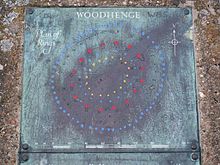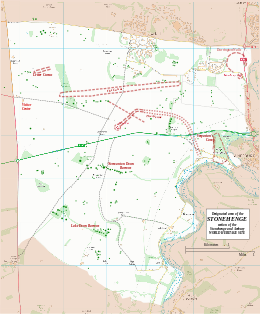Woodhenge
Map showing Woodhenge and Durrington Walls within the Stonehenge section of the Stonehenge and Avebury World Heritage Site | |
| Location | OS SU150434 |
|---|---|
| Region | Wiltshire |
| Type | henge |
| History | |
| Periods | Neolithic |
| Site notes | |
| Excavation dates | 1926-8 |
| Archaeologists | Ben and Maud Cunnington |
| Condition | feint earthworks, concrete posts |
| Public access | Yes |
| Website | English Heritage |
| Designated | 1986[1] |
| Reference no. | 373 |
| Designated | 1929 |
| Reference no. | 1009133[2] |
Woodhenge is a Neolithic Class II henge and timber circle monument located in the Stonehenge World Heritage Site in Wiltshire, England. It is 2 miles (3.2 km) north-east of Stonehenge in the parish of Durrington, just north of Amesbury.
Discovery
Woodhenge was identified from an aerial photograph taken by Squadron Leader (later Group Captain) Gilbert Insall, VC, in 1926.[3] during the same period that an aerial archaeology survey of Wessex[4] by Alexander Keiller and OGS Crawford (Archaeology Officer for the Ordnance Survey) was also being undertaken. Although some sources attribute the identification of the henge to Crawford, Crawford himself credits its discovery[5] to Gilbert Insall. However the site had been previously found in the early 19th century and described as an earthworks and thought to be a disc barrow. It was originally called Dough Cover. Maud Cunnington and B.H.Cunnington subsequently excavated the site between 1926 and 1929.[6] confirming that it was indeed a henge.[7]
Date
Pottery from the excavation was identified as being consistent with the grooved ware style of the middle Neolithic, although later Beaker sherds were also found. So, the structure was probably built during the period of cultural similarities commonly known as the Beaker. The Beaker culture spans both the Late Neolithic and Britain's Early Bronze Age and includes both the distinctive "bell beaker" type ceramic vessels for which the cultural grouping is known as well as other local styles of pottery from the Late Neolithic and Early Bronze Age.
While construction of the timber monument was probably earlier, the ditch has been dated to between 2470 and 2000 BC, which would be about the same time as, or slightly later than, construction of the stone circle at Stonehenge.[8] Radiocarbon dating of artefacts shows that the site was still in use around 1800 BC.[9]
Structure

The site consists of six concentric oval rings of postholes, the outermost being about 43 by 40 metres (141 by 131 ft) wide. They are surrounded first by a single flat-bottomed ditch, 2.4 metres (7.9 ft) deep and up to 12 metres (39 ft) wide, and finally by an outer bank, about 10 metres (33 ft) wide and 1 metre (3.3 ft) high.[6] With an overall diameter measuring 110 metres (360 ft) (including bank and ditch,) the site had a single entrance to the north-east.[9]

At the centre of the rings was a crouched inhumation of a child which Cunnington interpreted as a dedicatory sacrifice, its skull having been split.[10] After excavation, the remains were taken to London, where they were destroyed during The Blitz, making further examination impossible. Cunnington also found a crouched inhumation of a teenager within a grave dug in the Eastern section of the ditch, opposite the entrance.[6]
Most of the 168 post holes held wooden posts, although Cunnington found evidence that a pair of standing stones may have been placed between the second and third post hole rings. Excavations in 2006 indicated that there were at least five standing stones on the site,[8] arranged in a "cove". The deepest post holes measured up to 2 metres (6.6 ft) – and are believed to have held posts which reached as high as 7.5 metres (25 ft) above ground. Those posts would have weighed up to 5 tons, and their arrangement was similar to that of the bluestones at Stonehenge. The positions of the postholes are currently marked with modern concrete posts – a simple and informative method of displaying the site.
Further comparisons with Stonehenge were quickly noticed by Cunnington – both have entrances oriented approximately to the midsummer sunrise, and the diameters of the timber circles at Woodhenge and the stone circles at Stonehenge are similar. Both of these sites also have avenues connecting to the river Avon, which represents a bridge between life and death. Upon excavation of the end of the avenues connecting to the River Avon, evidence of stone structures were found there as well.
Relationship with other monuments
Over 40 years after the discovery of Woodhenge, another timber circle of comparable size was discovered in 1966. Known as the Southern Circle, inside of what came to be known as the Durrington Walls henge enclosure, located only 70 metres (230 ft) north of Woodhenge.
There are various theories about possible timber structures that might have stood on and about the site, and their purpose, but it is likely that the timbers were freestanding, rather than part of a roofed structure.[8] For many years work on the study of Stonehenge had overshadowed any real breakthroughs in the understanding of Woodhenge. Recent ongoing investigations as part of the Stonehenge Riverside Project are now starting to cast new light on the site and on its relationship with neighbouring sites and Stonehenge.
Theories have emerged in which the sites may all be integrated into an overall layout, in which the structures were linked by roads, and which incorporated the natural features of the River Avon. One of these paths, consisting of a series of wide parallel banks and ditches referred to as Stonehenge Avenue, crosses the ridge between the two sites that would otherwise make them both visible from one another,[11] possibly connecting them physically as well as spiritually.
One suggestion is that the use of wood vs. stone may have held a special significance in the beliefs and practices involving the transformation between life and death,[6] possibly separating the two sites into separate "domains".[11] These theories have partially come about with the findings of bones of butchered pigs exclusively at Woodhenge, showing evidence of feasting, leaving Stonehenge as a site only inhabited by ancestral spirits, and not living people.[11] Stonehenge was found to have the remains of hundreds of cremated in the pits around the inside of the outer concentric baroew, known as Aubrey holes. The sites Woodhenge and Stonehenge both have long processions of earth leading away from it. A sort of pathway, that both connect to the River Avon. This river is thought to be the physical representation of the transition from life to death. As a ritual, on special days of the year, people may have float the ashes of loved ones down the river from Woodhenge to Stonehenge. Stonehenge is thought to be a site of pilgrimage, ritual, and burial. However, the burials that take place here are reserved for only notable members of society in the late neolithic and geographic area. These same possible representations have also been seen in ritualistic megalithic sites on the island of Madagascar, at least 4,000 years after the erection of Woodhenge.[11]
Other uses
- Woodhenge is a piece of music on the 1979 album Platinum and the 'b' side of the single "Blue Peter" by Mike Oldfield, and later appears in the compilation album The Platinum Collection.
See also
- List of archaeoastronomical sites by country
- Cuckoo Stone, a standing stone 500 metres to the west
- Avebury Henge
- Bluestonehenge
- Stonehenge
References
- ^ UNESCO World Heritage site No 373
- ^ English Heritage Scheduled Monument record: Henge monuments at Durrington Walls and Woodhenge, a round barrow cemetery, two additional round barrows and four settlements, accessed 24 January 2015
- ^ Crawford, Archaeology in the Field - 1953; page 49
- ^ Crawford/Keiller, Wessex from the Air - 1928
- ^ Crawford, Archaeology in the Field -1953; page 49
- ^ a b c d "Woodhenge". Pastscape. English Heritage. Retrieved 7 October 2012.
- ^ http://www.pastscape.org.uk/hob.aspx?hob_id=219050&sort=4&search=all&criteria=woodhenge&rational=q&recordsperpage=10
- ^ a b c "Woodhenge". World Heritage Site. English Heritage. Retrieved 7 October 2012.
- ^ a b "History and Research: Woodhenge". www.english-heritage.org.uk. English Heritage. Retrieved 7 October 2012.
- ^ "Stonehenge. Woodhenge, the origins". www.stonehenge-stone-circle.co.uk. Retrieved 19 November 2015.
- ^ a b c d Pitts, Mike (2008). "The Henge Builders". Archaeology. 61 (1). Retrieved 2 December 2015.


